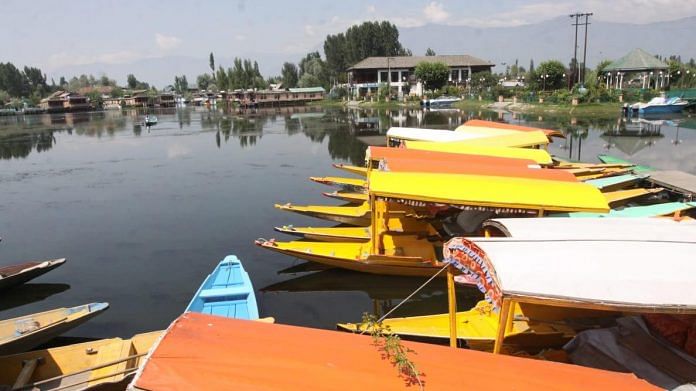Srinagar: The Jammu and Kashmir administration plans to conduct roadshows across the country as part of its outreach plan to rebuild the region’s image as a safe tourist destination.
The programme, named ‘Back to Valley’, has been initiated soon after the administration lifted a security advisory issued in August asking tourists and Amarnath Yatra pilgrims to leave the state. The advisory had cited a possible militant attack as the reason. Instead, the Centre revoked J&K’s special status on 5 August, and imposed a massive clampdown on civilian movement and communication.
According to sources, the administration also plans to request the Union tourism ministry for a “special endorsement”.
“The tourism sector will pick up pace if the Centre assures the people of India and of the world that Kashmir is safe to visit,” said a source in the administration.
Also read: Are we going to succumb to militants — govt full-page ad questions Kashmir people’s curfew
Declining tourism
According to government data accessed by ThePrint, only 10,130 tourists visited the Valley in August compared to 86,134 in the same month in 2018. In September, the number fell by more than 50 per cent to 4,562.
The total number of tourists to have visited Jammu and Kashmir this year stands at 5,37,165. Last year, the number was 8,30,758, while in 2017, it stood at a massive 12,28,638.
“The security advisory asking tourists and yatris to leave J&K was the first of its kind. It took us time to analyse the effects it will have on the tourism sector, which contributes roughly 6 per cent towards J&K’s GDP,” a senior official said.
“The setbacks that we have suffered in the months of August and September have to be tackled. ‘Back to Valley’ aims to do that. We also plan to initiate an aggressive advertising campaign to assure people that it is safe to visit Kashmir.”
Officials also expressed their surprise at the number of tourists that visited Jammu and Kashmir during the crisis. They attributed it to a lack of information about the situation.
“On one hand, 15,000 tourists visiting the state in August and September showed that people do want to visit Kashmir despite all odds,” said another government official.
“However, the visits were not long ones. A lot of them who had pre-booked their tickets to visit Kashmir, upon realising that the situation was not conducive here, decided to go back. This was in the first three weeks of August. The numbers fell sharply in September. We need to ensure the same does not happen in the coming months.”
Also read: 2 months on, J&K administration begins releasing Kashmiri politicians — mostly at night
Foreign tourists
According to tourism department officials, 860 international tourists visited Kashmir in August and another 650 in September. However, keeping a track of these visitors was a major task because of the communication blackout.
An Israeli female tourist, who had travelled to the Valley on 25 August, was untraceable for a month. Her family contacted the Indian embassy in Tel Aviv and a search was initiated — she was later found trekking in the Sonmarg region of Kashmir.
A South African tourist was also untraceable for nearly a week, and was later found “writing a book” in the Gangabal area of Ganderbal district, a police official said.
“In fact, on the day of the revocation, 137 foreign tourists were trekking in Gangabal. Usually, foreign tourists do a lot of research on areas they are about to visit. However, this time around some, who had pre-booked their tickets, decided to visit anyway. Some were even misled by misinformation campaigns. The government advisory issued in August should have been heeded,” a government official said.
Also read: 10 days after fierce gun battle began, ‘missing militants’ keep forces on edge in Kashmir
Stakeholders skeptical
Despite the advisory being lifted and the tourism department planning an outreach programme, stakeholders in the tourism sector appear skeptical about these developments due to the ongoing communication blockade.
Momin Ahmed, whose family owns two houseboats in Dal Lake, said that despite suffering massive losses, he would not advise his own clientele to visit because of the blockade.
“We would earn around 3.5 lakh to 4 lakh a month from March to November. The last two months, we didn’t have a single booking. I even had to let some of my staff go,” he said.
Noor Mohammad, who operates a shikara, would earlier earn Rs 10,000-12,000 a month, but his earnings in the last two months have not exceeded Rs 3,000.
Hotel owners also said that they had zero bookings in September and that they are still unable to register bookings due to lack of internet access.
“Guests could become a liability if things go sour,” said a hotel manager near Dal Lake.







One, create those safe conditions on the ground. Through a process of osmosis, the reassuring news will spread. Second, allow journalists of independent persuasion, including those from abroad, unfettered access to Kashmir. They will spend their own money and their reports will carry conviction.